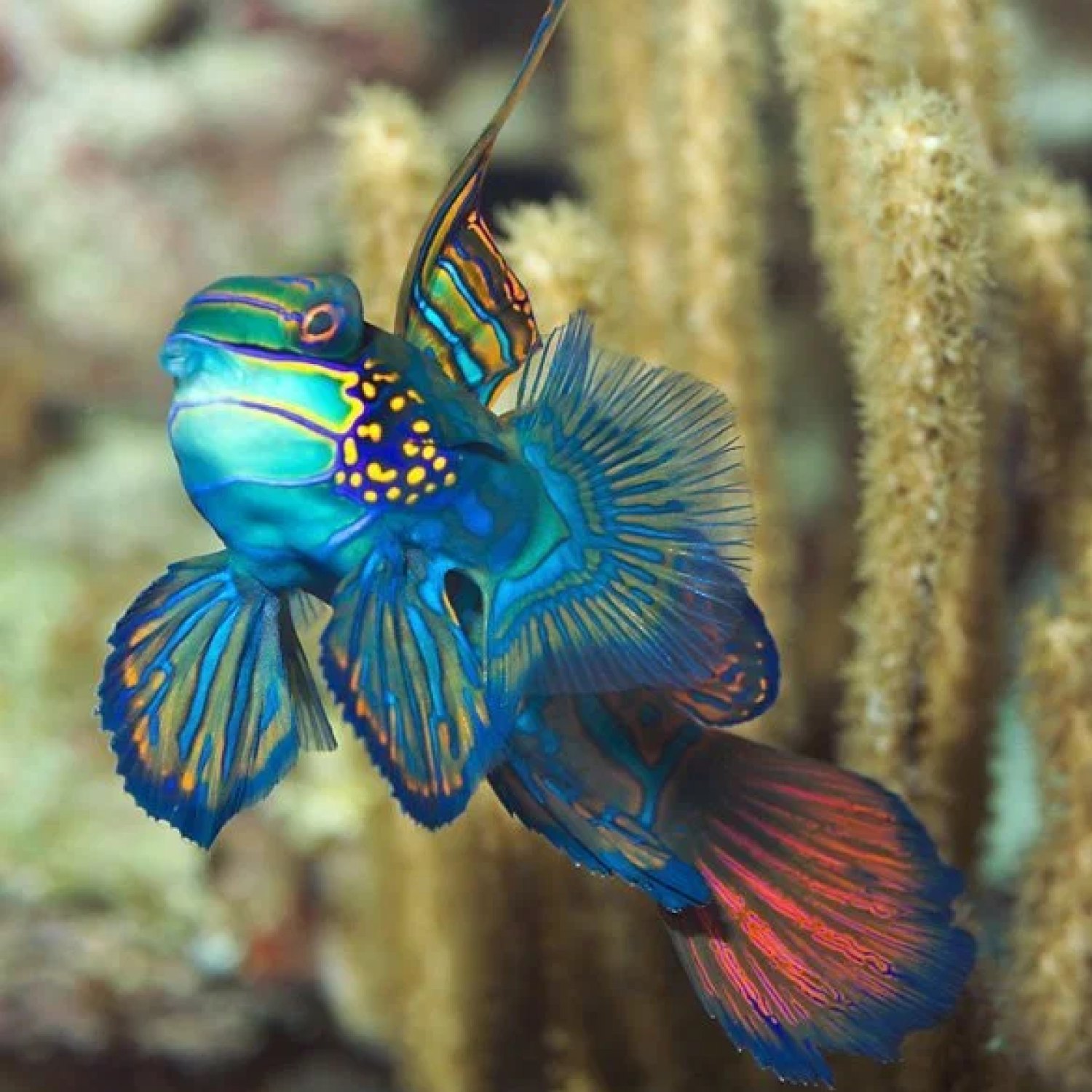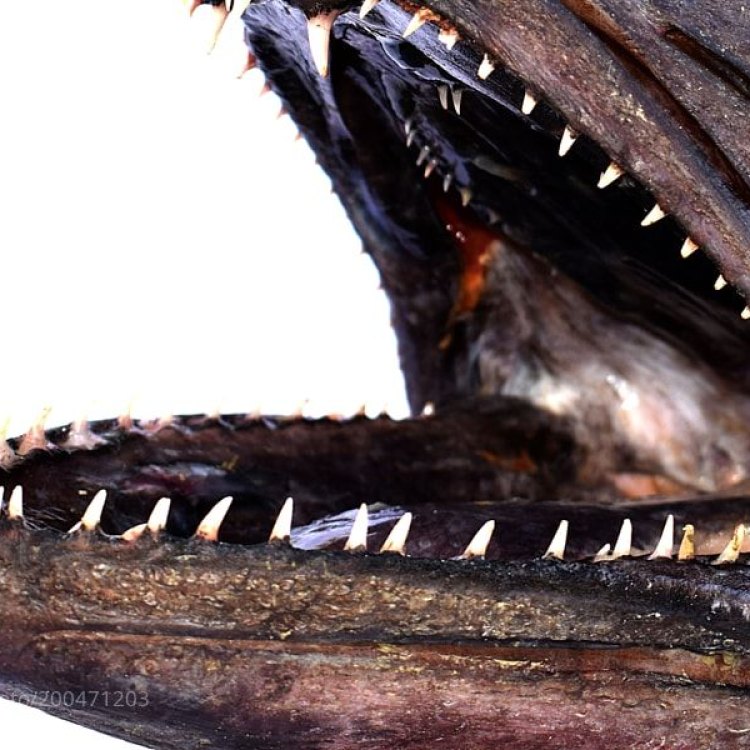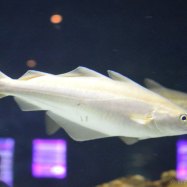
Oilfish
Up to 4 feet
The oilfish, also known as escolar or white tuna, can grow up to 4 feet long and has an elongated and cylindrical body. Belonging to the Gempylidae family, it can be found in the Atlantic, Indian, and Pacific Oceans. While it is a popular choice for sushi, be cautious as its high oil content can cause digestive issues. Catch them if you can, but consume in moderation!
Animal Details Summary:
Common Name: Oilfish
Kingdom: Animalia
Habitat: Deep sea
The Mysterious Oilfish: An Elusive Creature of the Deep Sea
Deep in the dark and unexplored parts of the ocean, there lives a mysterious creature that has captivated the curiosity of marine biologists and fishermen for centuries – the oilfish. With its elongated and cylindrical body, dark blue-black coloration, and impressive size of up to 4 feet in length and 110 pounds in weight, the oilfish (scientific name: Ruvettus pretiosus) remains one of the most elusive and enigmatic animals in the sea.While the name "oilfish" may evoke images of a slick and slippery creature, this deep-sea dweller has much more to offer than meets the eye. Let's dive deeper into the world of the oilfish and discover what makes it such a fascinating and unique creature Oilfish.
The Kingdom of the Oilfish
To understand the oilfish, we must first delve into its classification. Like all living things, the oilfish belongs to a specific kingdom, phylum, class, order, and family. According to scientific classification, the oilfish falls into the kingdom Animalia, making it an animal. From there, it belongs to the phylum Chordata, class Actinopterygii, and order Perciformes.As an actinopterygian, the oilfish is characterized by its bony fins and jaw, which give it the ability to move and feed efficiently in the water. Within the order Perciformes, it belongs to the family Gempylidae, which includes other deep-sea dwellers such as escolar and snake mackerels. This family is known for its long and slender bodies, making them well-suited for navigating the deep and vast expanse of the ocean.
A Quiet Life in the Deep Sea
One of the most intriguing aspects of the oilfish is its habitat – the deep sea. Found in the tropical and warm temperate oceans around the world, this creature lives in a world that is mostly hidden from human eyes Olingo. The deep sea, also known as the abyssal zone, starts at a depth of 3,300 feet and extends all the way to the ocean floor, which can reach depths of over 13,000 feet.In this dark and cold environment, the oilfish has evolved to thrive. Its dark blue-black coloration blends in with the dark waters, allowing it to remain invisible to potential predators. Yet, despite its elusive nature, the oilfish is a known migratory species and can be found at various depths, from 300 to 3,300 feet, depending on the time of day and season.
A Carnivorous Predator
The oilfish is not only a master of disguise but also a skilled predator. As a carnivore, its main source of food consists of other deep-sea fish, such as squid and crustaceans. With its powerful jaws and sharp teeth, the oilfish can easily take down large prey. However, its unique feeding method has led to some controversy and earned it a less flattering nickname – the "butterfish."The oilfish contains high levels of wax esters in its flesh, which can cause gastrointestinal distress in humans if consumed in large quantities. As a result, it is banned for sale in some countries, and warning labels are required in others. This has led to confusion regarding the true identity of the fish, with some mistakenly labeling it as the butterfish in fisheries and markets.
A Worldwide Distribution
Despite its controversial reputation, the oilfish can be found in many parts of the world, making it a truly international species. Its geographical distribution spans across the Atlantic, Indian, and Pacific Oceans, and it has been documented in various countries, including the United States, Japan, South Africa, and Australia.However, due to its deep-sea habitat, little is known about the oilfish's population and distribution. It is thought to be relatively abundant in its range, but its elusive nature makes it difficult to study and track.
A Unique Body Shape
In addition to its distinct coloration, the oilfish also has a unique body shape that sets it apart from other fish in its family. Its body is elongated and cylindrical, with a sharp, pointed head and a tapered tail. This body shape allows the oilfish to swim efficiently in the water, making it a formidable predator.Furthermore, this shape enables the oilfish to remain stable and balanced in the deep sea's strong currents, giving it an advantage over other fish that may struggle to navigate the turbulent waters.
A Giant of the Deep Sea
In the vast and unexplored world of the deep sea, the oilfish is undoubtedly one of the largest and most impressive creatures. With a maximum length of up to 4 feet and a weight of 110 pounds, it is considered a giant among the deep-sea fish.Its large size is a result of its predatory lifestyle and abundant food supply in the deep sea. With few natural predators and plentiful prey, the oilfish can reach impressive sizes in its lifetime.
A Setback to Its Survival
The oilfish may be a formidable predator, but it still faces threats to its survival. As a migratory species, it can easily fall victim to bycatch in fishing nets meant for other fish. Furthermore, its high wax ester content has led to human consumption controversies, causing declines in its population in some areas.Conservation efforts are still scarce for the oilfish, as there is little known about its population and habits in the deep sea. However, sustainable fisheries and responsible consumption can help ensure its survival and prevent any further declines.
A Mysterious Creature, Yet to Be Fully Understood
Despite its size, range, and unique characteristics, the oilfish remains a truly mysterious creature. With its quiet life in the depths of the ocean, it has evaded human eyes for centuries, leaving us with only snippets of information about its biology and behavior.There is still much to uncover about this enigmatic fish, and with advancements in technology and deep-sea exploration, we may one day be able to unravel its mysteries and fully understand its role in the deep sea ecosystem.
In conclusion, the oilfish is a fascinating and unique creature that thrives in the deep sea, away from human eyes and interference. With its remarkable body shape, powerful jaws, and impressive size, it is a force to be reckoned with in its environment. However, its survival remains threatened, highlighting the need for further research and conservation efforts to protect this mysterious and elusive creature of the deep sea.

Oilfish
Animal Details Oilfish - Scientific Name: Ruvettus pretiosus
- Category: Animals O
- Scientific Name: Ruvettus pretiosus
- Common Name: Oilfish
- Kingdom: Animalia
- Phylum: Chordata
- Class: Actinopterygii
- Order: Perciformes
- Family: Gempylidae
- Habitat: Deep sea
- Feeding Method: Carnivorous
- Geographical Distribution: Tropical and warm temperate oceans
- Country of Origin: Found worldwide
- Location: Atlantic, Indian, and Pacific Oceans
- Animal Coloration: Dark blue-black
- Body Shape: Elongated and cylindrical
- Length: Up to 4 feet

Oilfish
- Adult Size: Up to 6 feet
- Average Lifespan: Around 10 years
- Reproduction: Sexual
- Reproductive Behavior: Unknown
- Sound or Call: No specific sound or call
- Migration Pattern: Unknown
- Social Groups: Solitary
- Behavior: Aggressive and opportunistic predator
- Threats: Overfishing
- Conservation Status: Not evaluated
- Impact on Ecosystem: Can impact the populations of smaller fish
- Human Use: Commercial fishing
- Distinctive Features: Large size and oily flesh
- Interesting Facts: Oilfish has a high oil content in its flesh, which can cause gastrointestinal distress if consumed in large quantities by humans.
- Predator: May be preyed upon by larger predatory fish

Ruvettus pretiosus
The Fascinating World of the Oilfish: A Mighty Predator of the Sea
The ocean is home to a vast array of creatures, many of which remain a mystery to us. One such creature is the Oilfish, a large, predatory fish that roams the depths of our oceans. This elusive and fascinating fish has many unique features that make it stand out from the rest of the marine world. From its size to its behavior and impact on the ecosystem, the Oilfish is a truly remarkable creature that deserves our attention PeaceOfAnimals.Com.The Oilfish, also known as Escolar or Ruvettus pretiosus, is a species of fish found in tropical and subtropical waters around the world. It is a member of the Gempylidae family, which includes other predatory fish such as the Escolar and the Snake Mackerel. The Oilfish can grow up to a whopping 6 feet in length, making it one of the largest fish in its family. With its imposing size and aggressive behavior, the Oilfish is a formidable predator in the ocean.
Unlike some other species of fish, the Oilfish has a relatively short lifespan of only around 10 years. This may seem short in comparison to some other marine animals, but for a predatory fish, it is quite average. The exact length of an Oilfish's lifespan may vary depending on factors such as its environment and food availability.
One of the most intriguing aspects of the Oilfish is its reproductive behavior. As it is with many deep-sea creatures, not much is known about how the Oilfish reproduces Oranda Goldfish. However, what we do know is that they reproduce sexually, with males fertilizing females through external spawning. Beyond that, their reproductive behavior remains a mystery.
As for communication, the Oilfish does not have any specific sound or call. Unlike some marine creatures that use sound for communication or navigation, the Oilfish prefers to communicate through its aggressive and opportunistic behavior.
Similar to other deep-sea creatures, the Oilfish’s migration patterns are not well-documented. It is believed that they may undertake long-distance migrations in search of food or breeding grounds, but this remains largely unknown.
The Oilfish is a solitary fish, preferring to swim alone rather than in schools or groups. This may be due to their aggressive nature, as they are known to be territorial. They also have a well-developed sense of smell, which they use to detect prey and mark their territory.
Speaking of behavior, the Oilfish is a fierce predator that will stop at nothing to catch its prey. It is opportunistic and will attack any smaller fish that crosses its path, making it a dominant predator in its natural habitat. With its superior speed and agility and sharp teeth, the Oilfish is a force to be reckoned with in the ocean.
However, despite their ferocity, Oilfish are not without threats. Overfishing poses a significant threat to their population, as they are often caught as bycatch in commercial fishing. Due to their large size and oily flesh, they are often caught alongside other species of fish, and their numbers are dwindling as a result. This poses a significant risk not only to the Oilfish itself but also to the balance of the marine ecosystem.
Despite being a vital part of the ocean’s food chain, the Oilfish is not currently listed as an endangered species. However, they have not been evaluated for their conservation status, so there is much that we don’t know about their populations and the potential threats they face.
As with many other predatory fish, the Oilfish can have a significant impact on the ecosystem if their numbers are not carefully monitored. They are known to prey on smaller fish, and their aggressive behavior and large size can have a domino effect on the population of other marine creatures. This highlights the importance of understanding and protecting the delicate balance of our oceans.
Other than being a vital part of the marine ecosystem, the Oilfish also has some human uses. Commercial fishing is the main source of human use for this species, with their oily flesh being sought after for its high content of oil. However, there is a caveat to consuming Oilfish. Because of their high oil content, they can cause gastrointestinal distress if consumed in large quantities. In fact, several countries have banned the sale of Oilfish due to this risk. Thus, while their flesh may be a lucrative commodity, it is essential to consume it in moderation.
Apart from its distinctive features, the Oilfish also has some interesting facts associated with it. As mentioned earlier, their high oil content can make them a risky choice for consumption. However, their oily flesh also allows them to swim at higher depths with less effort, making them perfectly adapted to their deep-sea habitat.
Additionally, the Oilfish is known to be preyed upon by larger predatory fish such as sharks and tuna. Being a formidable predator itself, it may come as a surprise that the Oilfish can also become prey. This is perhaps a reminder that no matter how fierce a creature may seem, there is always something bigger and stronger lurking in the depths of the ocean.
In conclusion, the Oilfish is a remarkable and enigmatic creature that roams the depths of our oceans. From its impressive size to its aggressive behavior and impact on the ecosystem, there is much to learn and appreciate about this mighty predator. It reminds us of the vast and mysterious world that lies beneath the surface of the ocean, waiting to be explored and understood. Let us hope that we continue to protect and preserve this magnificent species, along with all the other creatures that call the ocean their home.

The Mysterious Oilfish: An Elusive Creature of the Deep Sea
Disclaimer: The content provided is for informational purposes only. We cannot guarantee the accuracy of the information on this page 100%. All information provided here may change without prior notice.












